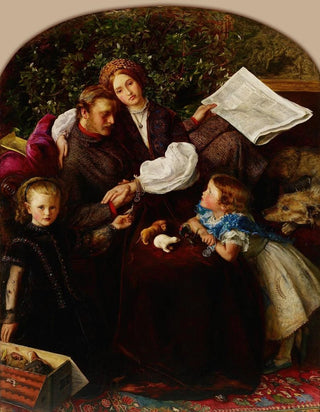Art print | Peace Concluded - Sir John Everett Millais


View from behind

Frame (optional)
At the heart of the Pre-Raphaelite movement, the artwork "Peace Concluded" by Sir John Everett Millais stands as a vibrant testament to the harmony between nature and humanity. This painting, created in 1856, depicts a scene that is both intimate and universal, where peace is symbolized by a couple in full communion. Millais, a master of color and light, manages to capture the very essence of this suspended moment, where every detail seems to pulse with its own life. The scene unfolds in an idyllic setting, where lush nature serves as the backdrop to a declaration of love and reconciliation. The work invites the viewer to immerse themselves in a universe where the tensions of war give way to the tenderness of human bonds.
Style and uniqueness of the work
The uniqueness of "Peace Concluded" lies in how Millais combines striking realism with an almost dreamlike atmosphere. The characters, beautifully rendered, are enveloped in vibrant colors that seem to dance under the light. Millais excels in the art of detail; each element, whether it be the clothing of the protagonists or the flowers surrounding them, is treated with remarkable precision. This attention to nature results in a rich and varied palette, where deep greens and vibrant reds blend harmoniously. The artist also employs a carefully orchestrated composition, where lines and shapes guide the viewer’s gaze toward the heart of the scene. Thus, "Peace Concluded" is not merely a simple representation but becomes a true sensory experience.
The artist and his influence
Sir John Everett Millais, an emblematic figure of the pre-Raphaelite movement, left a mark on art history with his innovative approach and unique vision. Born in 1829, he quickly established himself as a prodigy, attracting the attention of his contemporaries with his exceptional talent. Millais’s influence extends beyond his era, inspiring many artists who followed him. His commitment to faithful representation of nature and human emotions paved the way for a new artistic sensibility. By integrating

Matte finish

View from behind

Frame (optional)
At the heart of the Pre-Raphaelite movement, the artwork "Peace Concluded" by Sir John Everett Millais stands as a vibrant testament to the harmony between nature and humanity. This painting, created in 1856, depicts a scene that is both intimate and universal, where peace is symbolized by a couple in full communion. Millais, a master of color and light, manages to capture the very essence of this suspended moment, where every detail seems to pulse with its own life. The scene unfolds in an idyllic setting, where lush nature serves as the backdrop to a declaration of love and reconciliation. The work invites the viewer to immerse themselves in a universe where the tensions of war give way to the tenderness of human bonds.
Style and uniqueness of the work
The uniqueness of "Peace Concluded" lies in how Millais combines striking realism with an almost dreamlike atmosphere. The characters, beautifully rendered, are enveloped in vibrant colors that seem to dance under the light. Millais excels in the art of detail; each element, whether it be the clothing of the protagonists or the flowers surrounding them, is treated with remarkable precision. This attention to nature results in a rich and varied palette, where deep greens and vibrant reds blend harmoniously. The artist also employs a carefully orchestrated composition, where lines and shapes guide the viewer’s gaze toward the heart of the scene. Thus, "Peace Concluded" is not merely a simple representation but becomes a true sensory experience.
The artist and his influence
Sir John Everett Millais, an emblematic figure of the pre-Raphaelite movement, left a mark on art history with his innovative approach and unique vision. Born in 1829, he quickly established himself as a prodigy, attracting the attention of his contemporaries with his exceptional talent. Millais’s influence extends beyond his era, inspiring many artists who followed him. His commitment to faithful representation of nature and human emotions paved the way for a new artistic sensibility. By integrating






